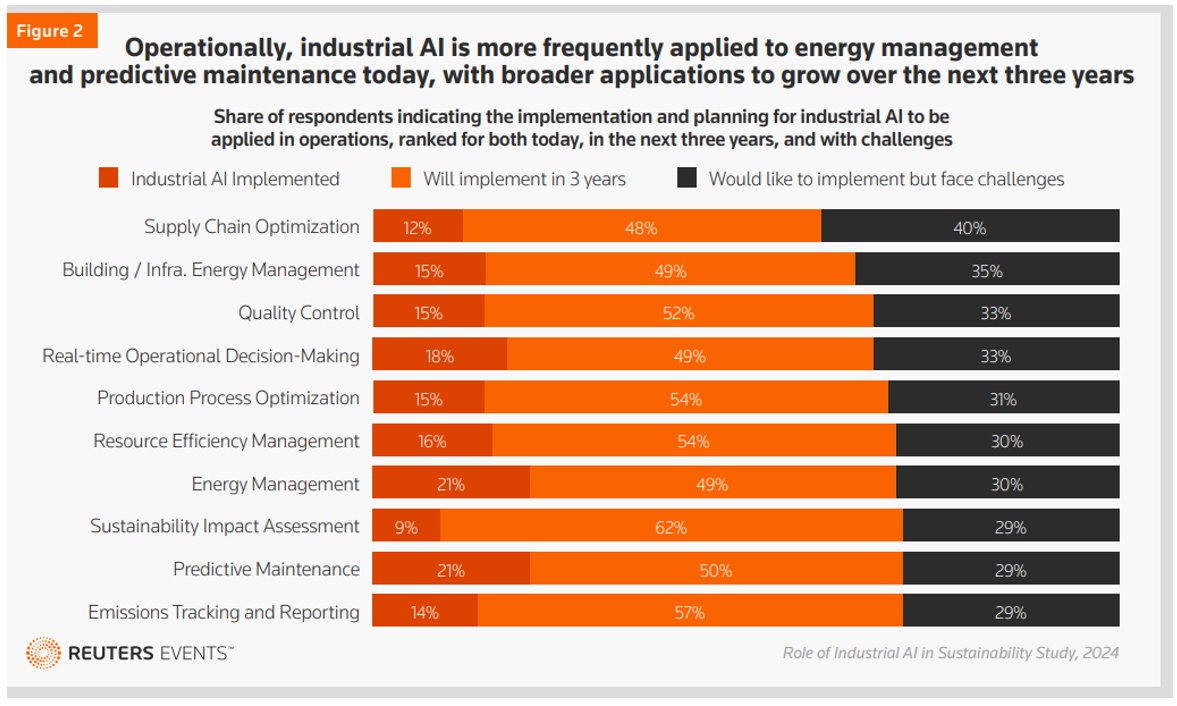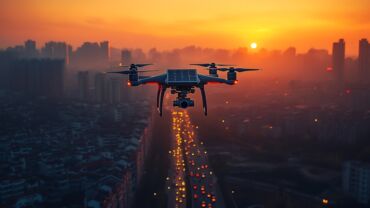Industrial AI offers significant potential for enhancing corporate sustainability strategies, but widespread adoption faces challenges including ROI projection difficulties, energy consumption concerns, and the need for greener AI infrastructure
In its most recent earnings call, Alphabet, the parent company of Google, announced that it plans to spend $75 billion to expand its investment in in AI and other advanced technologies. But what is the cost of this on the environment, given the corresponding energy demand increase that this will spur?
Generative AI (GenAI) offers promising opportunities for efficiency and effectiveness on corporate sustainability strategy execution. In fact, 70% of respondents indicated that future innovation in sustainability will be driven by industrial AI applications and solutions, according to research on industrial AI and its impact on sustainability conducted by Reuters Events and Siemens. Yet, 38% of these respondents said that the biggest challenge for AI’s further adoption is or projecting return on investment (ROI).
Indeed, this is particularly challenging for doing so in industries that consume natural resources intensively and that assess, predict, and optimize the design, production, sourcing, and operations of products.
Current and future state of industrial AI
Many predict that 2025 is the year that AI will be adopted on enterprise-wide scales. At the same time, industrial AI may lag this expectation. Operationally, industrial AI is more frequently applied to energy management and predictive maintenance with only 21% of respondents stating that industrial AI is being used today.
Conversely, at least 48% of respondents said they expect to implement industrial AI solutions and tools over the next three years in areas such as supply chain optimization (with 48% of respondents citing this area) and sustainability impact assessment (62%).

Of those respondents that said they are currently applying industrial AI, multiple use cases to optimize supply chains, production process, and sustainability impact assessments are being pursued.
Greening of AI processing & infrastructure
In addition to projecting the ROI of AI adoption, other challenges exist. The most prominent one is the computer processing power used and the amount of energy that is consumed in the use of AI. While innovations — like DeepSeek’s announcement that it engineered hacks to address pre-training costs in its reported efforts to achieve high performance with dramatically less computation power — are notable, many agree that the dropping cost of AI usage on a per token basis will actually increase demand of AI and thus increase the overall energy demand on a global scale. (A token is a unit of measurement that calculates the cost of processing power of large language models.)
In a recent podcast, Goldman Sachs experts referred to this concept as the Jevons Paradox, which is the tendency of abundance increasing as the price of something declines. When applying this to industrial AI, this means that as the cost of AI usage on a per token basis declines, more people will use AI because it is more cost effective, and as a result, energy demand may increase overall.
To help scale industrial AI usage across enterprises, several developments must occur to help realize the potential of industrial AI’s positive impact on sustainability. According to our recent research, this includes:
-
-
- Net balance must be positive — The energy used to train and run AI should be net positive by the reduction of environmental impact achieved through product or end-process optimization.
- Green data centers are the future — Smart infrastructure that propels decarbonization and energy efficiency is needed for sustainable AI development.
- AI must become greener — The efficiency of an AI-compute-per-power unit needs to increase significantly, particularly for cooling. Data processing and storage demand is soaring, and sustainability transformation within the industry is critical to achieve net zero ambitions.
-
Solutions to other challenges
In addition to the greening of AI development and data infrastructure, the most prevalent challenges holding back more widespread adoption of industrial AI can be categorized into three specific areas, according to our research:
-
-
- Financial — As mentioned earlier, almost 40% of respondents said they have difficulty in projecting the ROI of AI. To overcome this challenge, look at AI investments at the business strategy level rather than just at the product level to better realize the beneficial efficiency, productivity, and sustainability gains.
- Partnerships — Take an ecosystem approach in pursuit of organizational AI strategies with partners. To achieve this, an open approach to collaboration across expertise and skillsets, translates to more companies (both large and small), governments, and academia working together in pre-competitive spaces.
- Capabilities — Reskill and upskilling multidisciplinary teams is a key component in wide-scale adoption of industrial AI. The lack of small groups of data scientists, data engineers, and domain business experts who can partner to solve common problems, for example, is one reason pilot programs fall flat in AI experimentation. By bringing together teams from complimentary disciplines — such as data scientists to create and develop the algorithms, data engineers to help capture the right data and store it properly, and business professionals who understand both the technology and broader business contexts — is essential in developing new capabilities to successfully implement industrial AI into business models.
-
As the cusp of a new era in industrial AI and sustainability are imminent, the potential for transformative change is immense. The challenges industries face are significant, but so are the opportunities. It is time for businesses, governments, and individuals to take action and embrace the power of industrial AI to drive sustainability forward.
You can start by assessing your organization’s readiness for AI adoption, identifying key areas in which industrial AI can make the most impact, and investing in the necessary infrastructure and talent. Collaborate with partners, both within and outside your industry, to share knowledge and resources. Most importantly, commit to the ongoing development of greener AI technologies and practices.
By working together and pushing the boundaries of what is possible, the full potential of industrial AI can be harnessed to create a more sustainable, efficient, and prosperous future for all.
You can find out more about the challenges that many industries face with sustainability here







